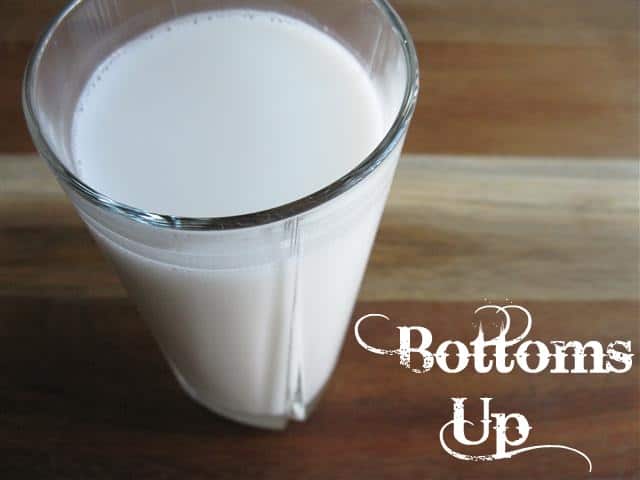
Coconut milk is easy to make; it requires only two ingredients – coconut and water – and minimal equipment. Making it at home yields both coconut cream and milk (if you let it stand in the fridge, the cream will rise to the top and the milk will sink to the bottom, just like what you would find if you were to open a can of coconut milk).
And even after extracting the milk, coconut pulp has its uses, so don't throw it out. Here are a few ideas for what to do with it:
- Add it to pancake, muffin, or cake batter
- Add it to cake frosting
- Add it to pudding
- Add it to oatmeal
- Add it to a smoothie
- Spread it on toast with a drizzle of honey
- Dry it out in the oven and use it as breadcrumbs for breading things like chicken
So now the $64,000 question: what does it taste like? (After all, in the end it’s the taste that really matters, right?) Coconut milk is subtly sweet and has a faint coconut aroma. It’s great to drink on its own or use in coffee, puddings, curries, soups, or pretty much anywhere else you would use milk. Coconut cream tastes like coconut milk, but with a thicker, richer consistency. Coconut cream works well as a cream substitute, and to make things like ice cream, curries, or whipped cream (just use an electric beater and whip until soft peaks form).
I really enjoyed making coconut milk. I’ve never milked a cow, but I can only imagine that making my own coconut milk was rewarding in the same way that milking a cow would be (you know, as Steinbeck said, the whole living off the fat of the land thing). I’m actually thinking of trying my hand at homemade rice and soy milk as well.
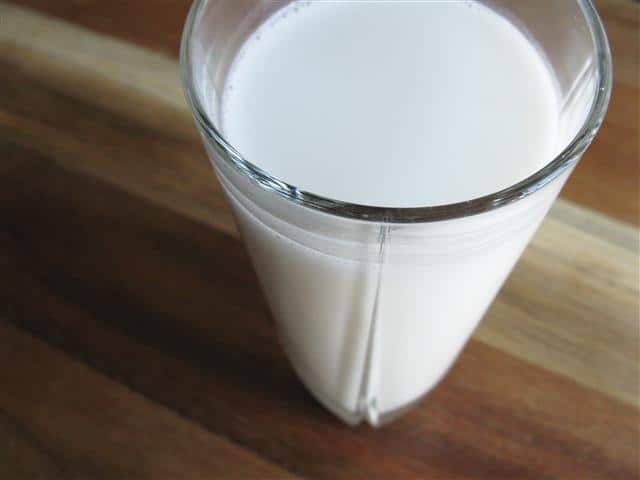
(Yield: About 1 ½ c after first press; about 4 ½ c after three presses)
6 oz desiccated (unsweetened shredded) coconut (about 2 ⅓ c)*
2 c boiling water for each of three presses
Equipment:
Strainer
Bowl
Cheesecloth
Food processor
Step 1: Line a strainer with cheesecloth (double thickness) and place the strainer over a bowl.
Step 2: Put the coconut in a food processor and carefully pour 2 c boiling water on top. Process for 45 seconds, then let the coconut cool a bit.
Step 3: Pour the pureed coconut into the cheesecloth.
Step 4: Gather together the corners of the cheesecloth and twist to wring out the milk.
Step 5: To do a second press (in which you will end up with more coconut milk and less coconut cream), repeat steps 2-4 with the same coconut, reusing the same piece of cheesecloth.
Step 6: Do a third press in exactly the same way as the second press.
The milk can be stored in the fridge for 1-2 days (it will separate into coconut milk and coconut cream).
*I used desiccated coconut, but you could also use fresh coconut here.
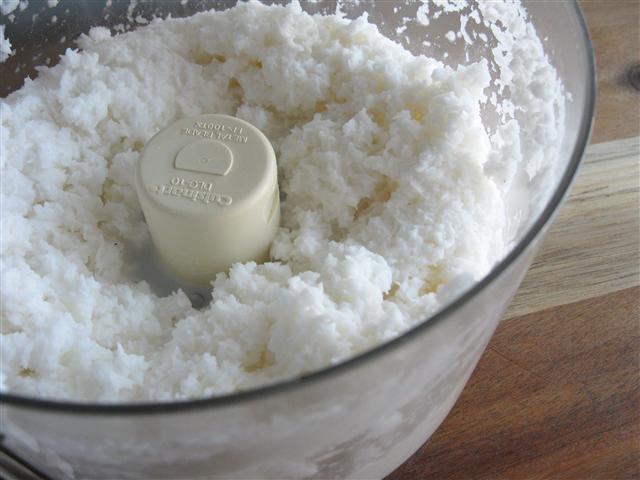
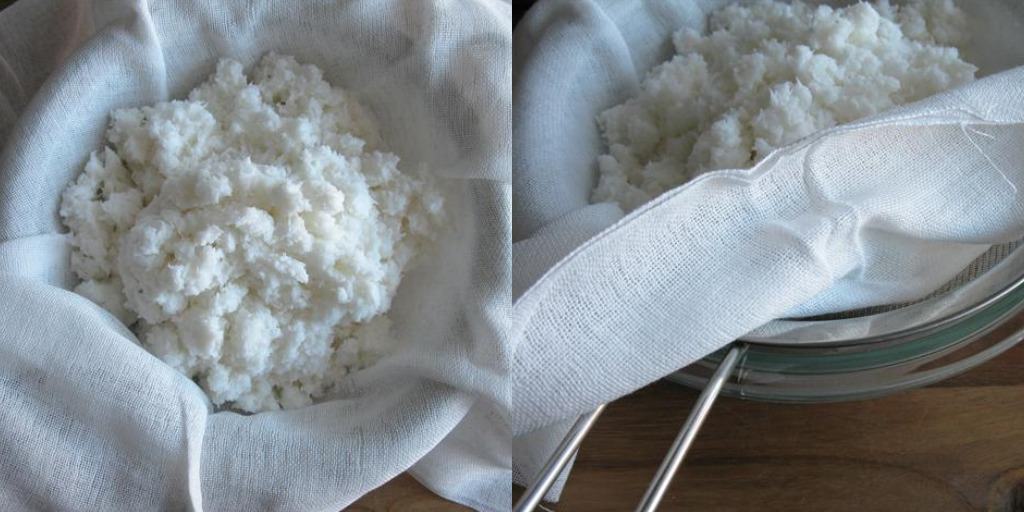
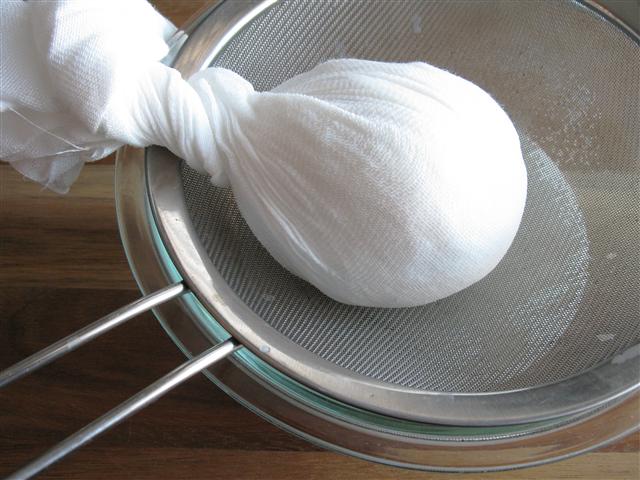

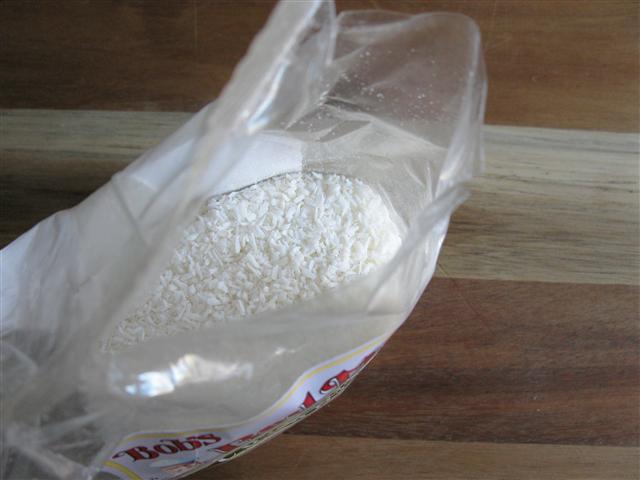
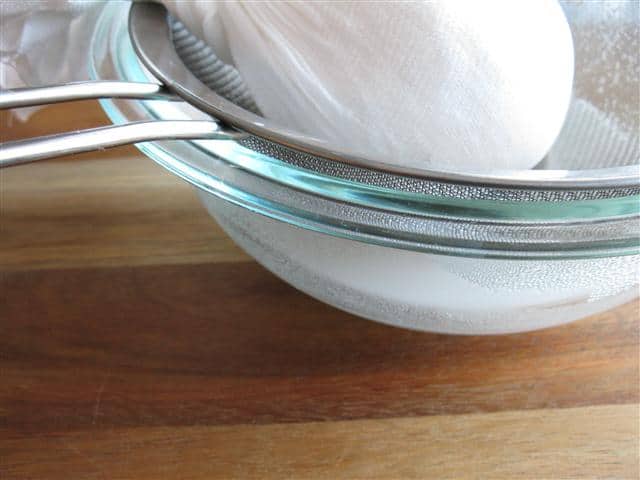
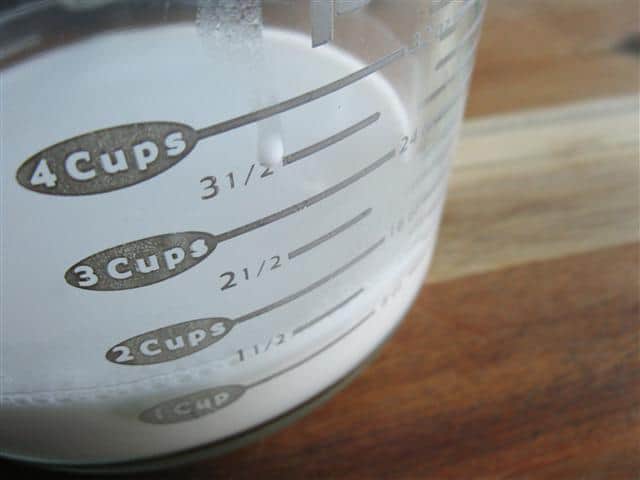


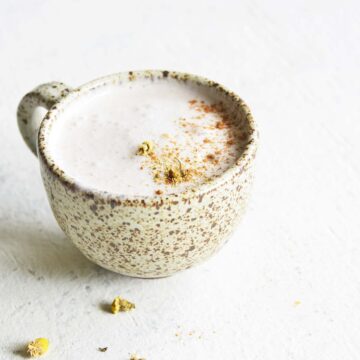
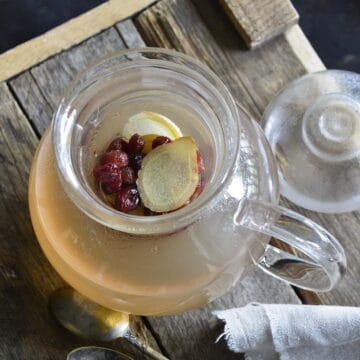
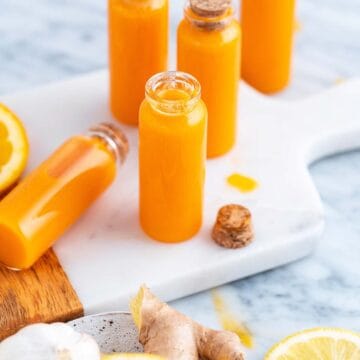
Maja says
Making it right now for the first time (thank you for the recipe!), I plan to use it for tapioca pudding :)
Magic of Spice says
I've used coconut milk often but never tried making it, does seem doable even for me :)
I can't wait to see soy and rice milks too...cool
Reeni says
I would of never thought it would be so easy! I just bought a whole bunch of coconut yesterday - can't wait to do this - you're a genius!
chriesi says
What a fantastic post!
Mia says
Oh i make coconut milk too , but for curries:-)
I love this post and ur pics!
I dont use the Cheese cloth thought and we actually dont find it here but i have a sub!!
ur coconut milk looks sooo creamy and good!
Erica says
Very nice rendition of how to make coconut milk!
Lazaro says
Faith,
I make my own coconut milk and know exactly how it tastes. May I have the $64cG's now? I'll give you a routing number.
Next level, huh? Rice and soy. Go for it. Anything homemade is much better than store bought. Your tutorial was masterful and your photos spot-on. Very well done.
I wonder how many people actually got the "kid" thing? Not many I would venture to guess.
5 Star Foodie says
This is very cool, to make your own coconut milk! An excellent tutorial and I'm bookmarking to do this for a cool project with 5 Star Foodie Junior.
Jeannie says
Interesting how you used dessicated coconut to extract milk. Lucky for me, coconut milk can be bought at the market very easily!
Louise says
sounds light and refreshing... my mind is thinking of all the ways to use it- i love how you are always thinking outide the box...
Michelle @ Find Your Balance says
Isn't that cool? I would have thought you needed fresh coconut but dried is so much easier to find. Very cool!
peachkins says
I love coconut milk, specially to make dessert or sweet soups..
Biren @ Roti n Rice says
I normally use coconut milk in cooking and not so much as a beverage. Recently, I found them in cartons at the health food store. Extracting your own is probably more economical. Thanks for sharing.
Nutmeg Nanny says
So tasty! Artie has been having issues with milk lately so we have been rocking almond milk in our house. I love adding coconut milk to pumpkin pie...sooooo tasty!
Lucy says
I've never thought of making my own coconut milk before - love the idea!
Jeanne says
Wow, I really want to try this! I wonder if I could make it without a food processor? I've actually never tried coconut milk, we generally use rice milk. But I'd be curious to try making rice milk as well.
Blond Duck says
I've heard so many people talk about this! I really need to try it.
MaryMoh says
Wow...that's really brilliant! I love coconut in my cooking. Never thought of extracting coconut milk from desiccated coconut. Would love to try one day. Thanks very much for sharing.
Krista says
Neat, Faith! I wonder if it would be good with unsweetened coconut? I find goat's milk products WAY easier on my stomach....
Megan says
Great info, Faith. My daughter is always asking me to buy a fresh coconut, and now I know what to do with it! Stumbled! :)
HPD says
darn it! i wanted to see a picture of you wielding a machete and attacking a few whole coconuts!
Barbara @ Modern Comfort Food says
What an excellent tutorial, Faith, and one that brings back such good memories! I lived for many years in the Philippines, where, at the time, the only way to obtain coconut milk was to make it oneself. Market ladies sold the just-ground fresh coconut meat in plastic bags, and we would take it home and make it just as you teach here, but minus the food processor. Just a whole lot of squeezing with one's hands!
Nicole, RD says
This looks sooooo good. I love coconut milk and all its creamy richness :) I love the "kid" joke...I thought it was funny, anyways :)
Mary says
I'm really impressed that you make your own coconut milk. It's something I never would have thought of doing and this is a great service to others who might like to try. I hope you are having a great day. Blessings...Mary.
Barbara says
I love coconut milk, use it all the time. Wonderful post, Faith, for people who have never tried it. I use it in so many recipes too.
Joanne says
What an awesome post and an amazing undertaking! I actually only drink almond milk because I like the taste and because I don't feel comfortable buying non-organic milk but organic is so expensive. Oh and because it's shelf stable. Major plus. This coconut milk looks amazing however. I just can't get over the fact that you made it yourself. Well done.
A Canadian Foodie says
I love posts like this. Practical, healthy, important. However, it is SO difficult to get a fresh coconut here. They are sold all of the time, but are almost always bad when I buy them.
Grrr.
:(
Valerie
Monet says
Amazing! I adore coconut milk, but I've never thought to make it at home. You should submit this to punk domestics. I think they would love it! Thank you for sharing. I hope your week brims with hope and joy.
Swathi says
Faith,
We used to extract coconut milk from fresh coconut. Getting from dessicated coconut is wonderful idea. I like it.
theUngourmet says
How cool! I'd love to try this. I love using coconut milk in so many of my recipes. Was the coconut very expensive? I have Bob's store right down the road and I may be able to get it in bulk.
Emily Z says
Okay, the "kid" joke is pretty bad... but I still laughed. But I tend to have a juvenile sense of humor, tee hee! ;) This is a fun idea, not something I would have thought to try on my own. Thanks for sharing! I went through a soymilk phase for a while, and then an almond milk phase... now we're back to cow's milk as we're supporting a local dairy's business by buying their products. Maybe sometime soon I should post about them. :)
Victoria says
Wow, this is easier than I thought. I figured you'd need to crack your own coconuts or something, but this is way better :) Thanks so much for sharing!
Julie M. says
That looks really good! I love how many uses there are for the used coconut as well. No waste! I'm a huge fan of coconut milk; I may have to try this!
Betty @ scrambled hen fruit says
I used to watch my dad milk our cow, but I've never seen anyone milk a coconut. :) This is a handy thing to know how to make- I always try to keep desiccated coconut on hand.
Anna Johnston says
Hahaha.... You and your sister.... hilarious, had a good chuckle at the unintentional pun used in teasing your 'kid' brother. :)
This post is wonderful Miss Faith, I've never tried to make my own coconut milk or cream... To the shops I go!
Lorraine @ Not Quite Nigella says
This will sound really silly but I didn't realise that you could get milk out of dessicated coconut! I thought once it was dessicated and dried then you couldn't and could only get it from fresh coconut meat. Thanks Faith! :D
Lori@FakeFoodFree says
Great post! I've never tried to make my own before, but I adore coconut milk. I'm interested to try both this and homemade almond milk.
Cara says
Wow!
That's so adventurous of you. I am sure it would be very rewarding.
ingrid says
I gotta tell Faith, while I like coconut milk I'm much too lazy to make my own. :)
~ingrid
Carolyn Jung says
I bet this beats the canned stuff by a long shot. The coconut milk looks so creamy and delicious. Thanks for showing us just how easy it is to make the real deal.
FOODESSA says
Faith...what don't you do? LOL
I'm always interested in how versatile you are in the kitchen ;o)
BTW...my 'Nonna' in Italy had to drag me kicking and screaming into the barn...and with all that...I still stood ground on never milking a cow. Now, making coconut milk, I can handle!
This was a great learning experience...thanks ;)
Ciao for now,
Claudia
Chef Dennis says
your too funny, I got this visual of you sitting on a stool under a coconut milking it....not quite the same as a cow!
I'd love to see your recipes for soy and rice milk!
Dennis
zerrin says
Dairy-free products are not common in Turkey. But this looks like a great way to make your own milk at home. By the way, I milked a cow as a child and it was so exciting! I'm sure your method is exciting, too.
Erica says
I am a huge fan of almond milk and always have it on hand. I am yet to try coconut milk. Maybe my first should be homemade- great recipe!
Katerina says
I have never made or seen how to make coconut milk. This post was very educative Faith. Thanks for sharing it with us.
BeadedTail says
That looked pretty simple and I'm sure it's really tasty! I can't stand soy milk so have been drinking almond milk. Might have to give this coconut milk a try!
Maria @ Scandifoodie says
Home-made coconut milk (as well as soy, rice and almond milk!) are soooo much better than any shop bought ones! Delicious!
Rosa says
Great! I love coconut milk.
Cheers,
Rosa
Evelyne@CheapEthnicEatz says
That is super cool, I am of to buy coconut today. And it will be easy to do even without a kitchen which is my problem now. I am more excited about the cream rising then the milk I think...just cool
Karyn (French Charming) says
Hi Gorgeous!
Thank you for this recipe...I've been hearing about more and more people drinking coconut and almond milk. I haven't had a glass of cow's milk in 20 years and i would love to give this a try. I love Carol's comment...my favorite candy bar...LOL!
I have missed you sweet friend and can't thank you enough for your friendship...you truly are one in a million and I adore your sweet and gentle soul...I am lucky to call you friend!
xoxo
Karyn
admin says
Karyn, Thanks so much for the lovely comment! You are such a dear, sweet friend and your words always brighten my day. Hope you have a beautiful day, sweetie! XO
Carol says
Looks like a good project! Looks so good, too!
I'm thinking chocolate syrup and it would be like drinking a mounds bar!